- Books Name
- CBSE Class 7 Social Science Book
- Publication
- Param Publication
- Course
- CBSE Class 7
- Subject
- Social Science
* Introduction
Desert is an arid region characterised by extremely high and low temperature and as scarce vegetation. Depending on temperatures there can be Hot and Cold Desert.
* The Hot Desert Sahara
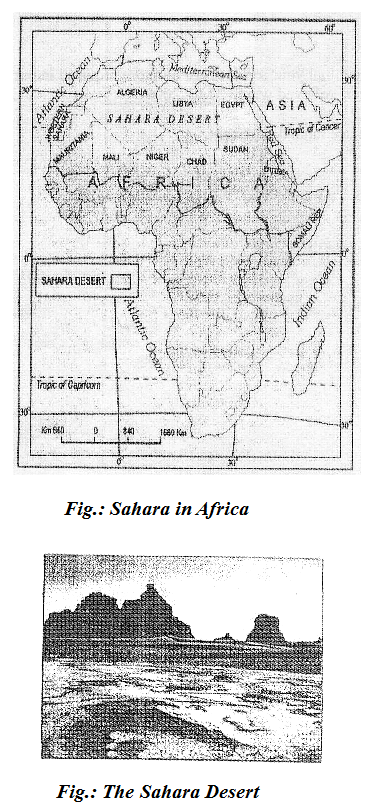
* LOCATION
(i) It is the world’s largest desert with an area of around 8.54 million sq. km.
(ii) The Sahara desert touches eleven countries like Algeria, Chad, Egypt, Libya, Mali, Mauritania, Morocco, Niger, Sudan Tunisia and Western Sahara of North Africa.
(iii) Besides the vast stretches of sands, Sahara desert is covered with gravel plains and elevated plateaus with bare rocky surface. These rocky surfaces may be more than 2500m high at some places.
* CLIMATE
(i) The climate of the Sahara desert in scorching hot and parch dry.
(ii) Has a short rainy season.
(iii) The sky is cloudless and clear.
(iv) Here, the moisture evaporates faster than it accumulates.
(v) Days are unbelievably hot and the night may be freezing cold with temperatures nearing zero degrees.
* FLORA
(i) Vegetation in the Sahara desert includes cactus, date palms and acacia.
(ii) In some places there are oasis-green islands with date palms surrounding them.
* FAUNA
Camels, hyenas, Jackals, foxes, Scorpions and many varieties of Snakes and lizards are found in Sahara.
* PEOPLE IN SAHARA
(i) The Sahara desert despite its harsh climate has been inhabited by various groups of people.
(ii) The Bedouins and Tuaregs:-
(a) These groups are nomadic tribes rearing livestock such as goats, sheep, camels and horses.
(b) These animals provide them with milk, hides from which they make leather for belts, slippers, water bottles; hair is used for mats, carpets, clothes and blankets.
(c) They wear heavy robes as protection against dust storms and hot winds.
(iii) The oasis in the Sahara and the Nile Valley in Egypt supports settled population. Since water is available, the people grow date palms.
(iv) Crops such as rice, wheat, barley and beans are also grown.
(v) Egyptian cotton, famous worldwide is grown in Egypt.
(vi) The discovery of oil - a product in great demand throughout the world, in Algeria, Libya and Egypt is constantly transforming the Sahara desert. Other minerals of importance that are found in the area include iron, phosphorus, manganese and uranium.
(vii) The cultural landscape of the Sahara is undergoing change:-
(a) Gleaming glass cased office buildings tower over mosques and superhighways crisscross the ancient camel paths.
(b) Trucks are replacing camels in the salt trade.
(c) Tuaregs are seen acting as guides to foreign tourists.
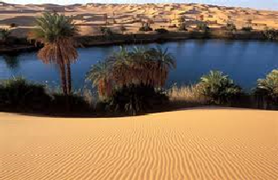
* The Cold Desert - Ladakh
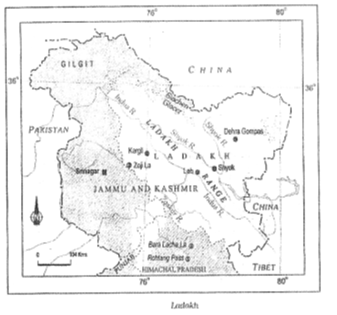
* LOCATION
(i) Ladakh is made up of two words- La meaning mountain pass and Dak meaning country.
(ii) Ladakh is also known as Khapa-chan which means Snowland.
(iii) Ladakh is a cold desert lying in the Great Himalays, on the eastern side of Jammu and Kashmir. The Karakoram Range in the north and the Zanskar mountains in the south enclose it.
(iv) Drass is one of the coldest inhabited places on earth located in Ladakh.
(v) Several rivers flow through Ladakh, Indus being the most important among them. The rivers form deep valleys and gorges.
(vi) Several glaciers are found in Ladakh, for example the Gangri glacier.
(vii) The altitude in Ladakh varies from about 3000 m in Kargil to more than 8,000 m in the Karakoram.
* CLIMATE
(i) Due to its high altitude, the climate is extremely cold and dry. The air at this altitude is so thin that the heat of the sun can be felt intensely.
(ii) The day temperatures in summer are just above zero degree and the night temperatures well below--30°C.
(iii) It is freezing cold in the winters when the temperatures may remain below -40°C for most of the time.
(iv) As it lies in the rain shadow of the Himalays, there is little rainfall, as low as 10 cm every year.
(v) The area experiences freezing winds and burning hot sunlight. For instance, you will be surprised to know that if sit in the sun will your feet in the shade, you may suffer from both sunstroke and frost bite at the same time.
* FLORA
(i) Due to high aridity, the vegetation is sparse.
(ii) There are scanty patches of grasses and shrubs for animals to graze.
(iii) Groves of willows and poplars are seen in the valleys.
(iv) During the summers, fruit trees such as apples, apricots and walnuts bloom.
(v) The finest cricket bats are made from the wood of the Willow trees.
* FAUNA
(i) Several species of birds are sighted in Ladakh like Robins, Redstarts, Tibetan snowcock, Raven and hoopoe are common.
(ii) Some of these are migratory birds
(iii) The animals of Ladakh are wild goats, wild sheep, yak and special kinds of dogs.
(iv) The animals are reared to provide for the milk, meat and hides.
(v) Yak’s milk is used to make cheese and butter.
(vi) The hair of the sheep and goat is used to make woolens.
(vii) The Chiru or the Tibetan antelope is an endangered species. It is hunted for its wool known as shahtoosh, which is light in weight and extremely warm.
* PEOPLE IN LADAKH
(i) The people here and either Muslims or Buddhists. In fact several Buddhist monasteries dot the Ladakhi landscape with their traditional ‘gompas’.
(ii) Some famous monasteries are Hemis, Thiksey, Shey and Lamayuru
(iii) In the summer season the people are busy cultivating barley, potatoes, peas, beans and turnip.
(iv) The climate in winter months is so harsh that people keep themselves engages in festivities and ceremonies.
(v) The women are very hard working. They work not only in the house and fields, but also manage small business and shops.
(vi) Leh the capital of Ladakh is well connected both by road and air. The National Highway 1A connects Leh to Kashmir Valley through the Zoji la pass.
(vii) Tourism is a major activity with several tourists streaming in from within India and abroad. Visits to the gompas, treks to see the meadows and glaciers, witnessing ceremonies and festivities are important activities.
(viii) Manali-Leh highway crosses four passes, Rohtang la, Baralacha la, Lungalacha la and Tanglang la. The highway opens only between July and September when snow is cleared from the road.
(ix) Life of people is undergoing change due to modernisation. But the people of Ladakh have over (the centuries learned to live in balance and harmony with nature. Due to scarcity of resources like water and fuel, they are used with reverence and care, thus nothing is discarded or wasted.
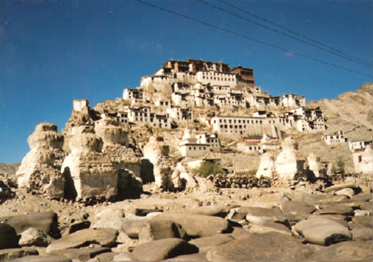
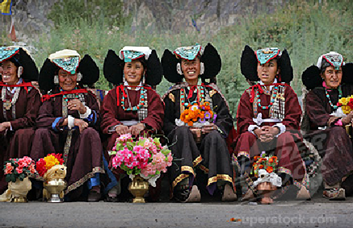

 Param Publication
Param Publication
